Avian Flu
Illnesses Worming etc includes
D.V.E.
Worming
Illnesses, Worming etc 2 includes
Angel wing
Coccidiosis
Poisons
Parasites
History of the Disease
When avian influenza outbreaks occur in poultry, quarantine and depopulation (or culling) and surveillance around affected flocks is the preferred control and eradication option in most areas .However, it is virtually impossible to fully eliminate the virus from the environment because it can stay hidden in ducks. Recent research findings give further cause for concern. New research suggests that H5 viruses are becoming more capable of causing disease (pathogenic) for mammals than earlier H5 viruses and are becoming more widespread in birds in the region. One study found that ducks infected with H5N1 are now shedding more virus for longer periods of time without showing any symptoms of illness. This has implications for the role of ducks in transmitting disease to other birds and possibly, to humans as well. Additionally, other findings have documented H5 infection among pigs in China and H5 infection in felines (experimental infection in housecats in the Netherlands and isolation of H5N1 viruses from infected tigers and leopards in Thailand), suggesting that cats could host or transmit the infection. These finding are particularly worrying due to the fact that reassortment of avian influenza genomes is most likely to occur when these viruses demonstrate a capacity to infect multiple species, as is now the case in Asia
Domesticated birds may become infected with avian influenza virus through direct contact with infected waterfowl or other infected poultry, or through contact with surfaces (such as dirt or cages) or materials (such as water or feed) that have been contaminated with the virus. People, vehicles, and other inanimate objects such as cages can be resposible for the spread of influenza virus from one farm to another. When this happens, avian influenza outbreaks can occur among poultry, these outbreaks occur worldwide from time to time. Since 1997, for example, more than 16 outbreaks of H5 and H7 influenza have occurred among poultry in the United States. The H5N1 virus is easily spread from farm to farm among domestic poultry through the feces of wild birds. The virus can survive for up to four days at 71 F (22 C) and more than 30 days at 32 F (0 C). If frozen, it can survive indefinitely so here in the UK it can transmit if imported
The current outbreak of bird flu is different from earlier ones in that officials have been unable to contain its spread. An outbreak in 1997 in Hong Kong was the first time the virus had spread to people, but it was much more quickly contained. A total of 18 people were hospitalized with six reported deaths. About 1.5 million chickens were killed in an effort to remove the source of the virus. Low pathogenic forms of avian influenza viruses are responsible for most avian influenza outbreaks in poultry. Such outbreaks usually result in either no illness or mild illness (e.g., chickens producing fewer or no eggs), or low levels of mortality. When highly pathogenic influenza H5 or H7 viruses cause outbreaks, between 90% and 100% of poultry can die from infection. Animal health officials carefully monitor avian influenza outbreaks in domestic birds for several reasons:Bird flu is not the same as SARS (severe acute respiratory syndrome). Although their symptoms are similar, SARS is caused by completely different viruses. Influenza viruses also are more contagious and cannot be as readily contained as SARS by isolating people who have the infection
Avian influenza viruses circulate among birds worldwide. Certain birds, particularly waterfowl, act as hosts for influenza viruses by carrying the virus in their intestines and shedding it. Infected birds shed virus in saliva, nasal secretions, and feces. Susceptible birds can become infected with avian influenza virus when they have contact with contaminated nasal, respiratory, or fecal material from infected birds. Fecal-to-oral transmission is the most common mode of spread between birds.Most often, the wild birds that are host to the virus do not get sick, but they can spread influenza to other birds. Infection with certain avian influenza A viruses (for example, some H5 and H7 strains) can cause widespread disease and death among some species of domesticated birds
Complicating the issue are traditional methods of farming in Asia that allow free-range ducks who roam from paddy to paddy to mix with chickens and other livestock.In Vietnam, for example, there are an estimated 59 million ducks, geese and other waterfowl, most raised in open-air backyard farms, according to agriculture figures.Vietnam has banned the breeding of ducks until June 30 2005. Ho Chi Minh City has ordered a cull of all ducks this month (March 2005
Evidence suggests that trade in live poultry, mixing of bird species in farms and markets, and poor biosecurity in poultry production play a much bigger role than wild bird movements, Agencies "advises against the destruction of wild birds and their habitats" since it is unlikely to have a major impact on controlling the bird flu
Experts have warned that the H5N1 virus, which has ravaged the region's poultry industry and killed 45 people across Thailand, Vietnam and Cambodia, could well become even deadlier if the virus mutates into a form that is easily transmitted between humans. So far there is no evidence of that, but health and animal experts say the longer it remains in the environment, the greater the chances of the virus changing and triggering a global pandemic that could kill millions
* Background
Influenza A (H5N1) is a subtype of the type A influenza virus. Wild birds are the natural hosts of the virus -- hence, the name avian influenza or bird flu. The virus was first isolated from birds (terns) in South Africa in 1961. The virus circulates among birds worldwide. It is very contagious among birds and can be deadly to them, particularly domesticated birds like chickens
* Infection
The virus does not typically infect humans. In 1997, however, the first instance of direct bird-to-human transmission of influenza A (H5N1) virus was documented during an outbreak of avian influenza among poultry in Hong Kong; the virus caused severe respiratory illness in 18 people, of whom 6 died. Since that time, there have been other instances of H5N1 infection among humans However, H5N1 viruses thus far have not been capable of efficient human-to-human transmission; health officials continue to monitor the situation closely for evidence of H5N1 transmission between people
* Spread
Infected birds shed virus in saliva, nasal secretions, and feces. Avian influenza viruses spread among susceptible birds when they have contact with contaminated excretions. It is believed that most cases of H5N1 infection in humans have resulted from contact with infected poultry or contaminated surfaces
WORMS, WATERFOWL etc
Many of you particularly if you keep a number of geese will run them with other livestock such as sheep or horses . If a combined worming programme is not used there can often occur a case of worm resistance in one of the breeds . As an example , if geese or ducks are kept with sheep , goats or cattle the larger species can be wormed and the wormer will cause them to shed parasite eggs . Many of these will be killed , the others are then picked up by the goose or duck and will pass through their system and later reinfect the host, this being a frequent cause of "worm resistance" . The smaller species may also suffer as they may be reinfected via the larger re distributing their own worm eggs
The simplest way to treat this is to use the same wormer on both species and if the makers labels and dose ratings are followed ( often with a calculator to reduce the dose from many kilo to one and a half!) . The option of adding a syringe to the mouth of individual geese is both time consuming and stressful to both owner and animals , a better method is to dilute the dose for the pen or pens and make up a wet mash or to soak the grain. Egg withdrawal for most makes is twenty four hours remembering that this is the day after worming as the eggs laid on the day of worming were produced during the previous day . (They can be added to food for growers but will not incubate)
Another option is to run species together which cancel out the worms of each other such as geese and horses . Many of the Victorian horse books talk of this being "efficacious" and is probably the reason for so many geese being painted in stable yards. For those without an "estate" the muscovy is a smaller version , although it is technically neither goose nor duck it is closer to the goose genetically and I personally sell a number of muscovies for general farmyard hoovering . Perhaps the only drawback to this is it enables a broody goose or muscovy to hide their clutch even more effectively making the young susceptible to small rodents and the resulting rugby scrum to collect the babies whilst being 'assisted by mum' is another story
DUCK VIRUS ENTERITIS-DVE
Identification
The virus may be isolated from the liver and spleen of birds dying from this infection. Virus can be recovered by infecting susceptible ducklings, in which the disease can be reproduced; by inoculating embryonated Muscovy duck eggs on the chorioallantoic membrane; or by inoculating cell cultures of duck embryo or Muscovy duck embryo origin. The identity of the virus can be confirmed by neutralisation tests using specific antiserum to inhibit pathological changes in the duck embryos or the cytopathological effects in the cell cultures, or by direct or indirect fluorescent antibody tests on infected cell cultures
DIAGNOSTIC TECHNIQUES
Duck virus enteritis (DVE) is an acute, sometimes chronic, contagious virus infection that occurs naturally only in ducks, geese and swans. The agent is a herpesvirus and similar to Newcastle Disease in chickens. The infection has not been reported in other avian species, mammals or humans. In domestic ducks and ducklings, DVE has been reported in birds ranging from 7 days of age to mature breeders. In susceptible flocks, the first signs are often sudden, high and persistent mortality with a significant drop in egg production. In chronically infected partially immune flocks, only occasional deaths occur. (In mine they did not stop laying and even laid eggs the morning they died
Clinical signs
associated with a DVE outbreak vary with the species, age and sex of the affected birds, and the virulence of the virus. In breeder ducks, the range of signs include photophobia (fear of light or apparent blindness), polydipsia, loss of appetite, ataxia, watery diarrhoea and nasal discharge. Birds often have ruffled feathers and soiled vents. Sick birds may maintain an upright stance by using their wings for support, but their overall appearance is one of weakness and depression. In ducklings 2-7 weeks of age, losses may be lower than in older birds, and the signs associated with DVE infection include dehydration, loss of weight, a blue colouration of the beaks, and bloodstained vents
REQUIREMENTS FOR VACCINES
A live attenuated virus vaccine can be used to control DVE in birds over 2 weeks of age. Fattening or breeding ducks may be vaccinated subcutane-ously or intramuscularly to produce an active immunity. The vaccine virus is not thought to spread by contact from vaccinated to unvaccinated ducks, as the unvaccinated birds remain susceptible to infection
Waterfowl diseases & illnesses 2
Angel Wing In Ducks And Geese
Angel wing, also known as slipped wing, crooked wing or drooped wing, is a condition of ducks and geese where the last joint of the wing is twisted and the wing feathers point out, and do not lay smooth against the body
It is more common in geese and typically in either the left wing or both wings, only rarely in the right wing only. Males develop it more than females. The birds that develop the problem are perfectly healthy, they are just not as nice looking
The cause of angel wing is thought to be a nutritional problem due to excess feed. You see, waterfowl that normally mature in the Arctic environment do not show any angel wing because of their naturally fast growth. It does appear, however, in those species that come from a more temperate environment where they grow slower under natural feeding conditions. But by feeding them unlimited, high protein, high energy feed, they grow unnaturally fast and their wing weight seems to outgrow the strength of the wing to support it. Further proof that this may be the cause can be found in an article that said "If their wings start drooping they are put on a diet of alfalfa; grass or layers pellets (instead of Chick Growers) until the condition clears up
The only wild waterfowl populations known to be affected are those fed by man. In Sweden, ten different park populations of Canada geese produced angel wing. The following year one flock was not fed any artificial feed and there were no angel wing goslings produced
We suggest not to feed high protein, high energy feed (such as turkey feed), provide plenty of room for exercise, keep in small groups, provide plenty of grass or green feed and keep the pen dark at night if possible so less eating occurs. If you do notice a twisted wing, however, you can form a sling to hold the wing in place to allow proper development
COCCIDIOSIS
Cause
Intracellular parasites coccidia; that live in the intestines
Ages affected. All ages, although ducklings are affected more severely
Source of infection. Coccidia are found wherever birds are kept. The life cycle of these protozoans consists of two phases
* A dormant form (oocyst) outside the host. This form is passed in the droppings. Under moist and warm conditions it reaches its infective stage (sporocyst) within 1&endash;2 days
* The multiplication stage within the host. Once the sporocyst is eaten by the bird, it hatches, penetrates, develops and multiplies within the intestinal cells. The organism reaches its final developmental stage (the oocyst) within 10 days and is passed in the droppings. As the sporocyst is resistant to most common disinfectants, low temperature and dry environments, ducks can be at risk of infection all year round. This is particularly true where young ducks are kept in large numbers on the ground. Under this type of husbandry outbreaks can occur, causing sudden and serious losses. With low stocking densities, low levels of infection probably occur in most ducks due to the occasional ingestion of a sporocyst dropoped by wild birds. Under normal circumstances this low level of infection is self-limiting, clinically non-apparent and eventually leads to immunity
Signs
Signs of infection vary and depend on the number of sporocysts ingested, the species of coccidia, age of the ducks and previous exposure to infection. In young ducklings (8 weeks) sudden death may be the only manifestation of the disease. Mortalities may drag on for weeks with a few ducklings being found dead each day. More commonly, however, outbreaks are acute and last between 12 weeks if untreated. Early signs may be present and include a tucked-up appearance, blood-stained vent, blood-tinged diarrhoea, and the inability to stand. In older flocks sub-optimal weight gain may be the only expression of the disease
Diagnosis
Of the 13 species of coccidia reported from domestic and wild ducks only a few have been properly described and identified. Not all 13 species are pathogenic (disease-causing), and a 30 definitive diagnosis of coccidiosis as a cause of mortality or morbidity requires the finding of lesions in the intestines (these are greyish white circular spots and/or haemorrhages) and the microscopic examination of both the intestinal contents and wall scrapings for the various developmental stages of coccidia
Treatment
To achieve satisfactory results ducks must be treated quickly. The drugs can be given in the feed or drinking water. It is better to put the medication in the drinking water, as ducks with coccidiosis tend to eat less. Various sulphonamides can be used. These drugs should be used in conjunction with vitamins K, A and B complex. The vitamins help in the control of intestinal bleeding and the regeneration of the damaged lining of the intestines. The sulphonamides should not be given over prolonged periods. The best results can be achieved by a 3-2-3 schedule (3 days medication, 2 days fresh unmedicated water and 3 days of repeat treatment). Of the sulphonamides, sulphadimidine given at 3 to 6 g per 10 ducks per day on the 3-2-3 basis is very successful. Control and prevention. Use good hygiene and a low stocking density. If you have had coccidiosis on your property, give low levels of sulphaquinoxaline (125 g/t feed) plus a multivitamin supplement for the first 8 weeks of life to keep the problem at bay. Alternatively, raising young ducklings off the ground can effectively prevent infection, especially if you have a high stocking rate and you do not wish to use medication continuously
POISONS AND TOXINS
Plant poisons
Numerous poisonous plants, chemicals and metals can cause nervous signs in free-range ducks when eaten in sufficient quantity. The presence of a poisonous plant does not necessarily mean that poisoning by that particular plant has occurred. Normally ducks discriminate against most poisonous plants, provided they are fed a well-balanced ration or have access to other greenfeed. Accidental ingestion of the odd poisonous seed and leaf ordinarily does not produce any adverse reactions. Only when the poisonous plant becomes a substantial part of the diet, or when minute quantities are consumed regularly over a long time, may signs be evident. The amount of plant material that will produce signs of poisoning depends to a large degree on the nature of the toxic principle, the part of the plant ingested and its stage of growth, soil and weather conditions and the general health of the flock
Chemical poisons
Lead
Some commercial preparations of lead that were used in paints and garden sprays, as well as metallic lead in the form of spent shot, can cause leg paralysis and a green-stained vent
Phosphorus
The yellow phosphorus used in bait for rodents and also in matches and fireworks can be poisonous to ducks if enough is consumed. Signs include depression, loss of appetite, diarrhoea, muscular weakness, paralysis, coma and death
Antifreeze solutions (ethylene glycol
Ducks gaining access to this chemical may consume large amounts it is sweet and sugary tasting thus irresistable, resulting in depression, muscle weakness and death.It is also poisonous to cats/rats/foxes and other mammals
Diazinon
This is an insecticide normally used on sheep, pigs and chicken runs. It is highly toxic to ducks. Signs of poisoning include inability to stand, tremors of the head and neck, and eventually death within 24 hours of exposure
Salt
Four to six grams of salt can be fatal to growing ducks. Signs include great thirst, diarrhoea, weakness, partial paralysis and intermittent muscular spasms
Medications
Any medication can cause losses and side effects when applied wrongly. Ducklings are particularly susceptible to nitrofurazone and furazolidone, and levels above 0.01 per cent can produce paralysis and other nervous signs. A characteristic of furazolidone poisoning is that birds have convulsions when forced to move. If sulphonamide compounds are given in excessive amounts or over periods longer than prescribed they will cause a stiff gait as well as other signs
WORMS
Cause
Ducks can be affected by any of the four types of worms that infest other domestic poultry roundworms (Ascaridia spp.); tapeworms; caecal worms (Heterakis spp.), and hairworms (Capillaria spp
Ages affected
All ages are affected, but older ducks have better resistance to worms than ducklings and generally show milder effects, if any. Young ducklings are particularly susceptible, and heavy worm infestations may kill them or stunt their growth
Source of infection
The duck can become infested with worms by eating various insects, slugs or earthworms that may harbour stages of each parasite, or by eating worm eggs passed in the droppings of other birds. Worm eggs hatch in various sections of the gut
Clinical signs
These vary enormously and will depend on the type of worms, degree of infestation and the age of the birds. Birds heavily infested with roundworms or hairworms may die suddenly. This often happens when large numbers of immature roundworms migrate through essential body organs .However birds more often do not die suddenly but develop poorly, become weak and eventually die. With heavy roundworm or hairworm infestation ducks almost always have a diarrhoea that can range from frothy yellow to blood-tinged. Occasionally they develop an unsteady gait and paralysis. With heavy tapeworm and caecal worm infestation ducks sometimes have diarrhoea, but often just show poor weight gain and a drop in egg production
Diagnosis
The diagnosis can be made instantly if there are a large number of worms in the intestines at post-mortem. Alternatively, intestinal scrapings or samples from fresh droppings can be examined under a microscope.**A home test is to put fresh droppings in a jam jar add water...worms swim out
Treatment
There are two approaches to worm treatment: * the use of broad-spectrum chemicals that are effective against the major groups of worms * the use of narrow-spectrum chemicals that are effective against a particular type of worm A good broad-spectrum treatment can be achieved by the use of levamisole(sheep wormer). This chemical is effective against both mature and immature stages of roundworms, caecal worms and hairworms. For the treatment of roundworms exclusively, the various piperazine-based compounds are highly effective, provided the dose rate is adequate. If you need to treat caecal worms and tapeworms you can use phenothiazine and mansonil respectively. The drug dibutyltin-dilaurate is also effective against tapeworms, but it can cause a 10% drop in egg production
Control and prevention
None of the chemicals mentioned earlier is effective against the egg stage of worms. Ducks run on deep litter or in open range will be reinfested unless husbandry and management procedures are directed towards prevention of reinfestation. You can achieve short-term prevention by repeating treatment of the whole flock after 2 weeks, 6 weeks and 3 months. Long-term solutions include various husbandry practices aimed at lowering the chance and degree of reinfestation. To minimise or prevent reinfestation with caecal worms, roundworms and hairworms, you should
* rotate runs
worm strategically at danger periods;* separate ducks of different age groups;* use reasonable stocking rates;* provide clean pens
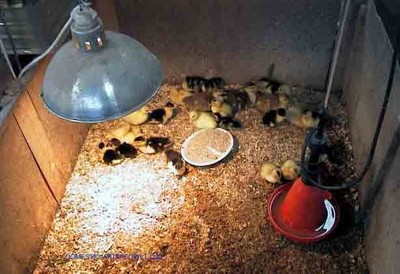
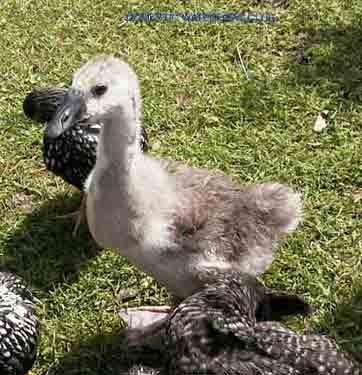

















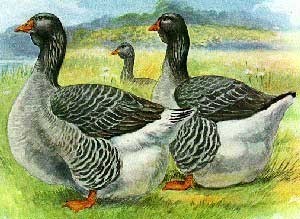











 Breeders
Breeders




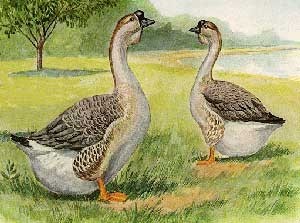







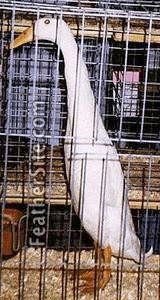

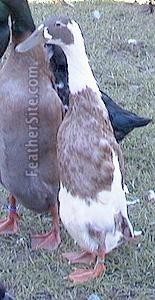
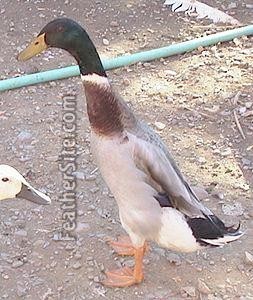




 Runner likes to fly
Runner likes to fly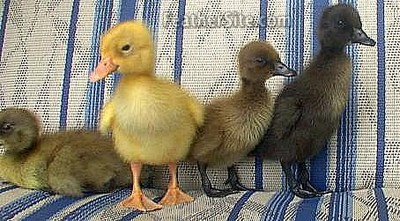 Runner Ducklings
Runner Ducklings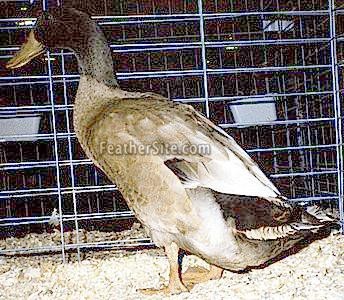
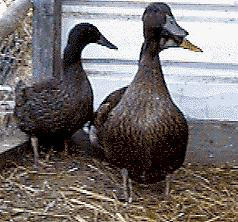



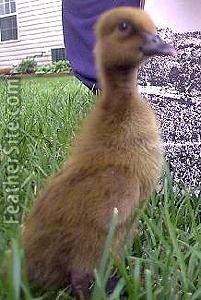
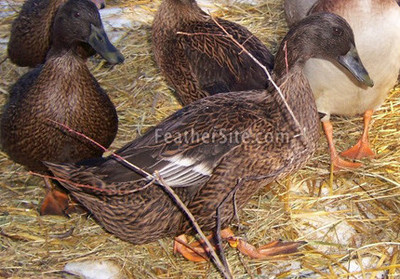

















 The following article appeared in our Yearbook and is from one of the leading Breeders
The following article appeared in our Yearbook and is from one of the leading Breeders



























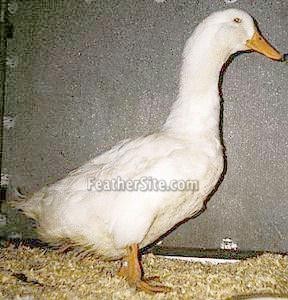
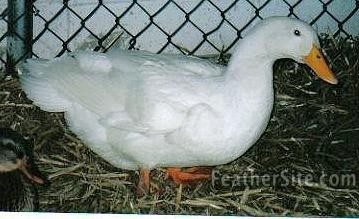





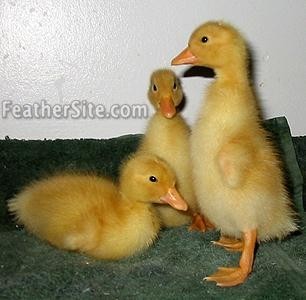
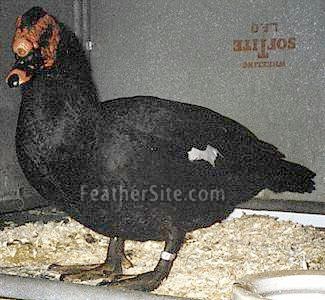
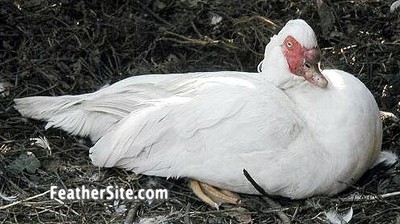

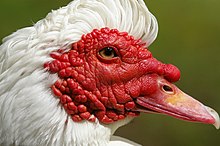


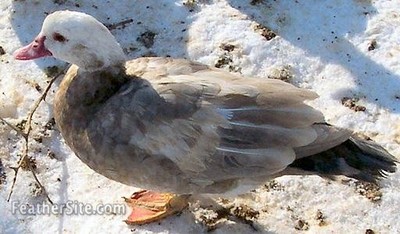
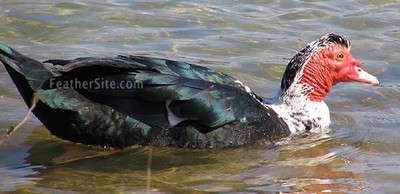
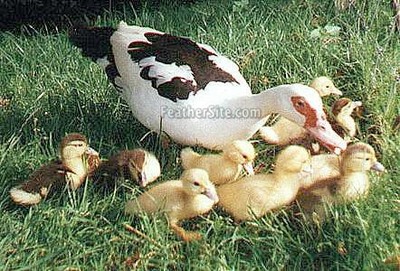
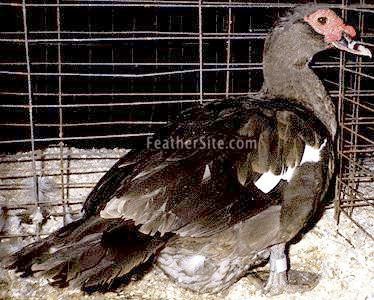
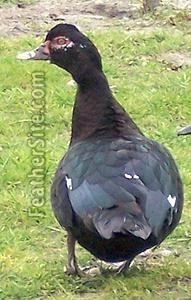
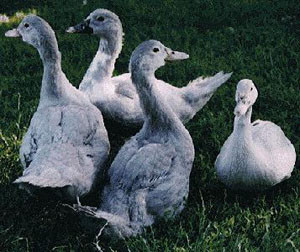
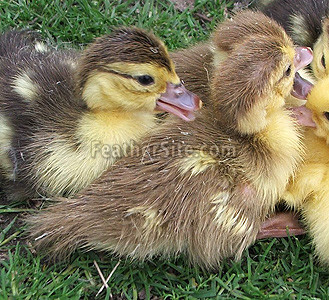
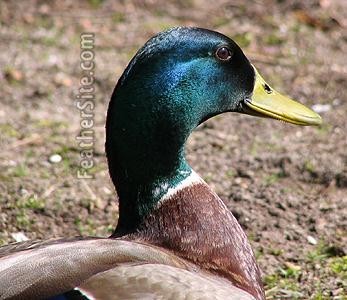
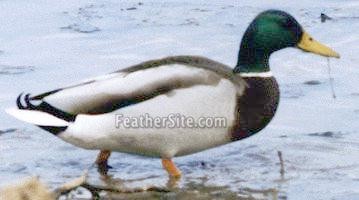
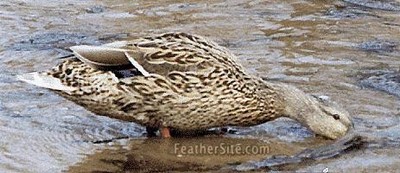
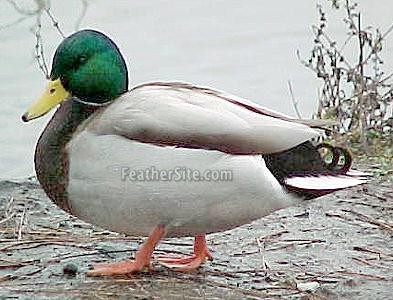
















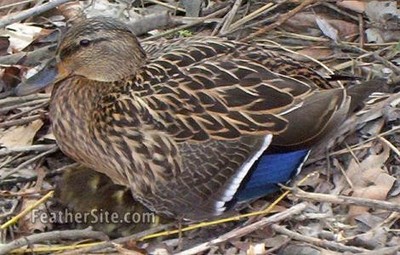 A Mallard hen on a new brood
A Mallard hen on a new brood